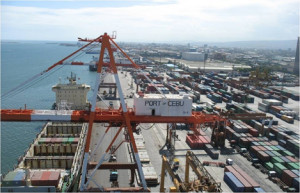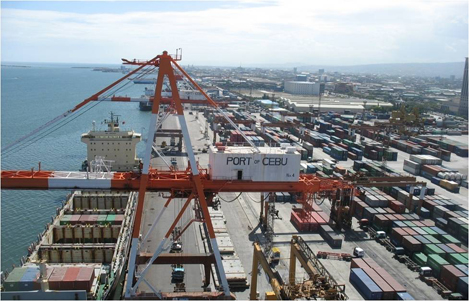 The Cebu International Port (CIP) recorded a 67% jump in average daily withdrawal of containers following implementation of higher storage charges for international cargoes.
The Cebu International Port (CIP) recorded a 67% jump in average daily withdrawal of containers following implementation of higher storage charges for international cargoes.
“From an average of 300 withdrawals of containers per day, (withdrawal) now rose to 500,” an official from the Cebu Port Authority (CPA) told PortCalls in an email.
The higher rates, under CPA Memorandum Circular No. 2 dated February 2, were implemented on March 3 following the Cebu Port Commission’s (CPC) Resolution 330-2015 on January 22 to increase rates for foreign cargoes, containerized (loaded and empty) and non-containerized, inbound or outbound.
From six calendar days, free dwell time of import containers was also reduced to five while the free period for export containers was reduced to four days from five days.
Storage rates for imports now range from P518 for a 20-footer from the 6th to 10th day (from the previous P269.53 per day), to as much as P1,747 for a 45-footer for the 31st day and beyond (from the previous P606.42 per day).
For export boxes, rates were increased to P81 for a 20-footer from the 6th to 10th day (from the previous P67.37 per day), to P434 for a 45-footer for the 31st day and beyond (from the previous P150.53 per day).
For Bureau of Customs-cleared containers beyond the applicable free storage period, fees rose to P5,000 per 20-footer, P8,750 per 35-footer, P10,000 for a 40-footer, and P11,250 for a 45-footer.
CPA said the increase in storage charges was necessary to decongest the port. “There is a high number of stored containers at the CIP even though they are already cleared with the Bureau of Customs,” it pointed out.
It added, “With the 30-year-old storage rates at the port, which are considerably low and cheap than storing containers outside but near the port, it has become convenient to make the port area a container yard. Therefore, CPA is trying to discourage this by imposing higher storage charges for cleared but overstaying cargoes.”
Last February at an international shipping conference in Manila, Atty. Annabel Pulvera-Page, legal and corporate development manager and chief legal officer of CIP cargo-handler Oriental Port and Allied Services Corp., said CIP has been experiencing berth and yard congestion since 2014 due to a number of reasons, including an increase in cargo volume and high dwell time; limited yard space and limited back up area for foreign operations; truck bans and bunching of trucks; and road and port repairs.
Opposition
The higher storage fees have gained opposition from stakeholders, who claim the policy will stifle commerce in the region.
In a letter addressed to CPC vice chairman and CPA general manager Edmund Tan last March 4, the Cebu Chamber of Commerce and Industry (CCCI), Philippine International Seafreight Forwarders Association-Cebu Chapter, and Cebu Business Club expressed “vehement opposition” to CPC Resolution No. 330-2015.
The group said they had submitted a joint position letter to CPA on June 11 last year explaining why the proposed increase was “onerous and tantamount to being confiscatory.”
“The strong opposition expressed by the different groups directly affected by the proposed measure notwithstanding, the Cebu Port Authority went on to pass the aforesaid resolution seemingly oblivious of the public clamor against its imposition,” the group claimed.
Although they recognize it is within the powers of the CPA to levy dues and impose rates and charges, they said “such exercise of authority should not be done in an arbitrary, capricious, whimsical and despotic manner.
“We are, therefore, urging your office to heed the call of the general public and revoke the resolution, which is not called for under the obtaining circumstances and which will surely stifle commerce.”
In a separate letter, Philippine Exporters Confederation–Cebu president Nelson Bascones said CPA’s rate increase and imposition of penalties will hit exporters who cannot even bring their containers inside the terminal earlier than 48 hours before the vessels arrive.
“Simple calculation tells us that exporters represent only a meager three percent utilization of the port during the current congestion…Exempting exporters from the penalties brought about by the congestion would be fair and just as we do not contribute to the congestion issue,” Bascones said.
CPA is standing pat on the policy. “CPA has recorded huge number of withdrawals which means that the intention of CPA of decongesting the port is showing progress,” the authority said, adding “the occupancy rate now at CIP has gone down and we can now consider early entry for exports and movement has shown better efficiency.”
The inclusion of export boxes in the policy, the port authority said, has to do with the “considerable number of containers for export that are also stored at CIP” which are shut-out containers (containers not loaded on their scheduled vessel).
“Although this is minimal as compared to imports, CPA is preventing the possible build-up of shut-out containers,” CPA added.
It said there are instances when the shut-out is authorized by the shipping lines due to non-availability of space in the vessel, and there are also instances where exporters themselves authorize the shut-out of containers due to documentation problems.
As for empty containers, CPA said charges are 125% higher than the loaded ones because “these containers should be faster in movement as there are no contents that will cause the Bureau of Customs to hold / alert (them).” – Roumina Pablo





